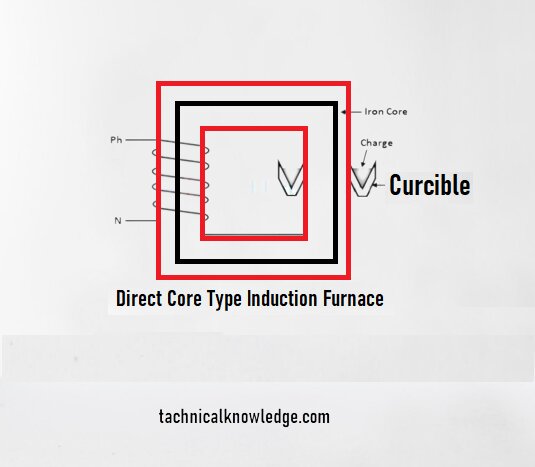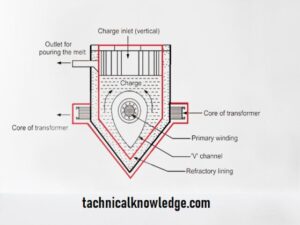
A core-type induction furnace works on the principle of electromagnetic induction. It consists of a cylindrical core made of graphite or other conductive material, which acts as the electrode. An electromagnetic field is produced as the alternating current flows through the core. This electromagnetic field makes the metal charge (to be melted) inside the furnace produce an alternating current (AC), which creates heat and melts the metal.
The following steps will explain how a core-type induction furnace works:
- Connected to the furnace’s core is an AC power supply.
- The AC current flows through the core, creating an electromagnetic field.
- The electromagnetic field induces an electric current in the metal charge placed inside the furnace.
- The induced electric current generates heat in the metal charge, leading to its melting.
- Once the metal is melted, it can be poured into a mold to form the destype of Induction Furnace
Type of Indication Furnaces
There are several types of induction furnaces; some of the most commonly used ones are:
- Core-type induction furnace
- Channel Type Induction Furnace
- Shell Type Induction Furnace
- Tilting Type Induction Furnace
- Vacuum Induction Furnace
- Medium Frequency Induction Furnace
- The High-Frequency Induction Furnace
- Ired shape. This type of furnace is preferred over other types of melting furnaces due to its high efficiency, fast heating, and low maintenance costs.
Each type of induction furnace has its own special features and is used for different tasks depending on production needs, cost, and how easy it is to use.
Core-Type Induction Furnace
A core-type induction furnace is an induction furnace that is used to melt metals and alloys. It consists of a cylindrical core made of graphite or other conductive material, which acts as the electrode. The alternating current flows through the core. This makes an electromagnetic field, which makes the metal charge inside the furnace produce an electric current. This induced electric current generates heat and melts the metal.

Core Type Induction Furnaces are preferred for small- to medium-scale production due to their high efficiency, fast heating, and low maintenance costs. The cylindrical shape of the core helps to produce a uniform magnetic field, which results in a uniform heating of the metal charge. This type of furnace can be easily cleaned and maintained.
Types Core Type Induction Furnace
There are several types of core-type induction furnaces, including:
- Dry Core Type Induction Furnace: It uses air cooling instead of water cooling to remove heat from the core. This type of furnace is preferred for small-scale production and is easy to operate.
- Wet Core Type Induction Furnace: It uses water cooling to remove heat from the core, making it more efficient and allowing it to handle larger loads. This type of furnace is preferred for high-volume production.
- Bottom-Pouring Core Type Induction Furnace: It is a type of Wet Core Type Induction Furnace with a bottom-pouring mechanism for easy and convenient metal discharge.
- Tilting Core Type Induction Furnace: It is a type of Core Type Induction Furnace that can be tilted for easy metal discharge.
- In order to improve efficiency and lighten the furnace, the coreless type of induction furnace uses a coil rather than a core.
Each type of core induction furnace has its own unique features and is used for specific applications based on the production requirement, cost, and operational convenience.
Disadvantages of a Core type induction furnace.
Some disadvantages of core-type induction furnaces include:
- Limited Capacity: Core-type Induction Furnaces are typically limited in their capacity to handle large metal charges, making them unsuitable for large-scale production.
- High Operating Costs: The cost of electricity required to operate the furnace can be high, especially when using a wet core type furnace that requires a constant water supply.
- Maintenance Requirements: The furnace requires regular maintenance to keep the core in good condition, which can be time-consuming and costly.
- Poor Temperature Uniformity: The cylindrical shape of the core can lead to poor temperature uniformity, resulting in inconsistent melting and poor quality of the metal charge.
- High Installation Costs: The installation cost of a Core-Type Induction Furnace can be high due to the need for special electrical and cooling systems.
- Metal Contamination: The metal charge can become contaminated with graphite from the core, which can negatively affect the quality of the end product.
- Limited Versatility: The furnace is typically limited to melting a specific type of metal, making it less versatile compared to other types of induction furnaces.
Overall, core-type induction furnaces are preferred for small- to medium-scale production where their advantages, such as fast heating and low maintenance costs, outweigh their disadvantages.
1-Channel Type Induction Furnace
A channel-type induction furnace is a type of induction melting furnace that utilizes a channel-shaped inductor to generate an electromagnetic field in order to melt metal. By sending an alternating current through the channel-shaped inductor, an eddy current is created in the metal, which makes it heat up and melt. This type of furnace is commonly used in foundries and metal casting operations.
2-Shell Type Induction Furnace
A shell-type induction furnace is a type of induction melting furnace that utilizes a cylindrical inductor (or “shell”) to generate an electromagnetic field in order to melt metal. The metal is heated by passing an alternating current through the cylindrical inductor, which induces an eddy current in the metal, causing it to heat up and melt. This type of furnace is commonly used in foundries and metal casting operations, and offers advantages such as faster melting times and improved energy efficiency compared to other types of melting furnaces.
3-Tilting Type Induction Furnace
A Tilting Type Induction Furnace is a type of induction furnace where the furnace vessel can be tilted to pour the melted metal into a mold or a holding container. The furnace vessel is heated by an induction coil that generates an alternating magnetic field. The metal inside the furnace vessel becomes electrically conductive and generates eddy currents, which cause the metal to heat up and melt. Tilting type induction furnaces are widely used in foundries and metal casting operations for their efficient heating and precise temperature control.
4-Vacuum Induction Furnace
A vacuum induction furnace is a type of induction furnace that operates in a vacuum environment. It is used to melt metals and alloys that are reactive, high-purity, and high-temperature. It is also used to make advanced materials and parts.
The vacuum environment in the furnace eliminates the reaction of the metal with the air and reduces contamination, resulting in a high-quality end product. The heating process in the vacuum induction furnace is similar to that of a core type induction furnace, where an alternating current is passed through a core to create an electromagnetic field, inducing an electric current in the metal charge.
This type of furnace is used a lot in the aerospace, electronics, and medical industries to make high-quality products that meet strict standards. Most vacuum induction furnaces are used for small-scale or specialized production because they are expensive to run and need a lot of maintenance.
5-Medium-frequency induction furnace
A medium-frequency induction furnace is a type of induction furnace that uses medium-frequency (MF) power (in the range of 500 Hz to 20 kHz) to melt metals and alloys. It consists of a core and a coil, through which the medium-frequency current flows to generate an electromagnetic field. This field induces an electric current in the metal charge, which generates heat and melts the metal.
Compared to traditional induction furnaces that use low-frequency power, medium-frequency induction furnaces have several advantages, such as faster heating times, better energy efficiency, and higher power density. In the metal industry, this type of furnace is used to make a lot of castings, ingots, and billets.
Due to their unique features, medium-frequency induction furnaces are preferred for high-volume production where faster heating and increased efficiency are important considerations. They are also used for special tasks like melting high-temperature metals, which depends on how quickly the furnace can heat up.
6-High Frequency Induction Furnace
A high-frequency induction furnace is a type of induction furnace that uses high-frequency (HF) power (in the range of 20–100 kHz) to melt metals and alloys. It consists of a core and a coil, through which the high-frequency current flows to generate an electromagnetic field. This field induces an electric current in the metal charge, which generates heat and melts the metal.
Compared to traditional induction furnaces that use low-frequency power, high-frequency induction furnaces have several advantages, such as smaller size, faster heating times, and better energy efficiency. This type of furnace is widely used in the production of small castings, coins, and other small metal parts for the jewelry, dental, and electronic industries.
Due to their compact size and high efficiency, high-frequency induction furnaces are preferred for small-scale production, prototyping, and research and development. They are also used in special situations where fast heating and precise control of temperature are important.

Leave a Reply